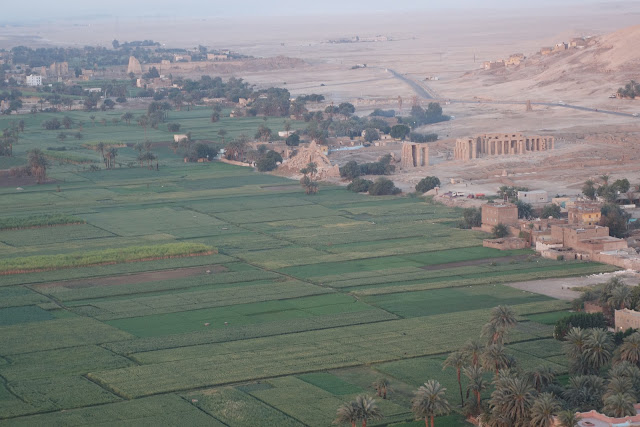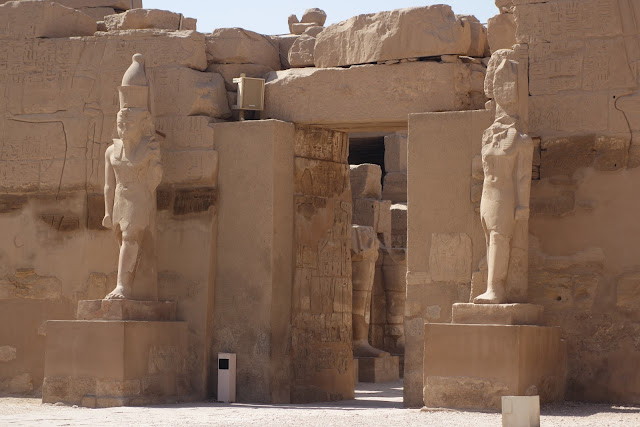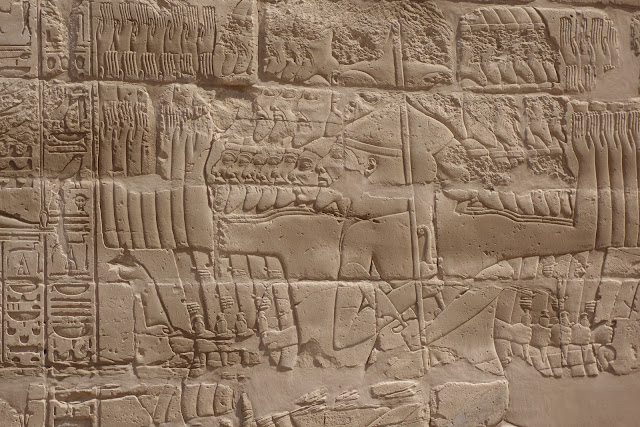I have spent the entire trip up to this time thinking, "The best, most interesting, and/or most novel days are behind us."
Nope. I'm still wrong.
We pulled out of bed at the crack of dawn to head off to our new day. We started with a solid, stick-to-your-ribs kind of breakfast.
Nope. I'm still wrong.
We pulled out of bed at the crack of dawn to head off to our new day. We started with a solid, stick-to-your-ribs kind of breakfast.
This adventure requires a boat ride before the sun comes up.
Here we are with our "I Love Mornings" faces on.
And here's our destination.
Yep. We are going ballooning today, because you know, what else does one expect to do in Egypt?
Yeah, neither did I until later. Thank goodness!
I am completely terrified of heights, but here I am.
I guess if we all go down, we all go down together.
Or as Judy is pointing out, "Let's go up!"
And up we went!
They managed to pack so many of us into the basket that I worried about getting off the ground.
But we made it!
The scenery from up here is stunning,
and revealing. Note to self: clean off the roof at home.
View of Hatshepsut mortuary temple, near the Valley of the Kings, currently undergoing a restoration.
The beautiful farmlands.
We could see
The sunrise was beautiful,
even with the very smoggy air.
If our balloon flames out, I have plans to make a jump for those soft looking trees,
or maybe this lush and green quilt.
I don't even want to know how high we were.
I thought we'd maybe aim for the road, but that wasn't the plan either.
Phew! We lived!
We're right in the middle of someone's sugar cane field. The farmer was NOT happy. He and our pilot chatted for some time, arms waving in the air, faces red, language colorful. At least, I think it was colorful. I don't know Egyptian, but it sure sounds intense when people are screaming it.
I was a little afraid we'd survived the balloon ride, but would lose our life in a field.
Stan figured he'd make a deal while we were waiting to die. He offered this cute little guy a dollar for one cane of sugar. This fella didn't speak any English, but he instantly grasped the deal.
Once again, I don't know Egyptian, but I'm positive I heard the equivalent of "Can you believe these crazy Americans?" A dollar for 1/4 a penny's worth of sugar cane???"
Stan broke up the canes and everyone who wanted some had a piece to munch on while we headed back to the ship. It wasn't gelato, but it was pretty good.
enjoying the variety of views along the way.
This is the second most popular tourist site in Egypt.
Karnak is a four-part religious complex, but only one part is open to tourists.
Karnak is unique in that is was developed and used over a very long time. People lived here from as long ago as 3200 BC. The first temples were constructed sometime between 2000-1700 BC. The part open to tourists is not quite that old. Even the newest areas were built somewhere around 305-30 BC.
As many as thirty pharaohs contributed to the building, creating a diversity of style and size that would otherwise not be possible.
We've seen so many temple ruins now, you'd think I wouldn't be impressed, but each had unique features. I was astonished at the number of ancient ruins in these countries, and viewing them never got old.
That would make this guy either a) dead at the time the statue was made, or b) the gardener.
Interestingly, the smaller statue on the feet of the larger is either a) alive at the time the statue was made, or b) the queen.
These enormous places were thought to be built using either levers or ramps or a combination of the two. It's hard to imagine moving these heavy, breakable parts around, even with modern equipment.
There are 134 columns in this hall.
Note the repeating figure. Our guide said this represents the journey to the next life.
This is the obelisk at Karnak. It is 97 feet tall and weighs 320 lbs. It belongs to Queen Hatshepsut and she claims they were built in 7 months
Here's the second obelisk. They left it right where it fell
Once we got into Egypt and Jordan, we encountered lots of school groups on field trips. I've got to say, that tops the field trips I took around the same age to the state fair, or copper mines.
These kids were also eager to practice their English, and often approached to say "My name is_______, what's your name?" in perfect English. When I told them my name, I often added my own question, such as "How old are you?" Immediately, a look of panic and confusion would cross their face and they would turn to the rest of the group, talking in excited voices. Clearly, they were still on lesson one and only knew one question.
This guy in the orange shirt and red hat is our guide.
Several pictures of the temple follow, so scroll down if you're bored by them.
These flowers are papyrus.
Stan, ensuring the obelisk of Thutmose I doesn't tip over. This obelisk is only 65 feet tall. Thutmose died in 1493 BC, meaning this obelisk was created before then.
Bus pictures are never great, but I couldn't resist these unique views.
I can't understand how the locals could stand the hot, heavy clothes they wore. It was very hot, and this isn't even the warmest time of year.
As I got off the bus, this woman stopped me and asked for money to feed her children. She seemed so embarrassed to ask, and I couldn't resist. I hope she's got air conditioning at home.
We have arrived at Luxor Temple. Really? People have to be reminded to not climb on monuments and leave their drums at home?
Ramses II, thought by many to be the greatest pharaoh of Egypt.
The massive job of excavation began in 1884 and continued sporadically until 1960.
Warning: more endless pictures of temple ruins.
These columns were unlike any other we'd seen and I love them.
. At the end of the day, we left our ship and moved on to Cairo.













































































































What a day. I think it was one of the most incredible of our trip, next to about fifteen other days. (Yeah, it's hard to rank them.) It is hard to beat a day that begins with a hot air balloon ride, followed by Karnack and Luxor. Wow. Great pictures!
ReplyDeleteThat balloon ride was a kick. Love your pictures of the fields and the soft trees (full of cobras). In the realm of Indiana Jones. Pinch me.
ReplyDelete